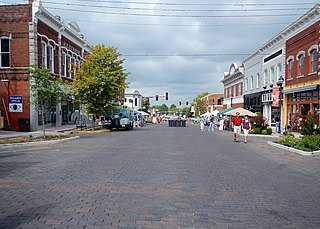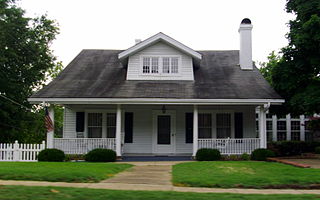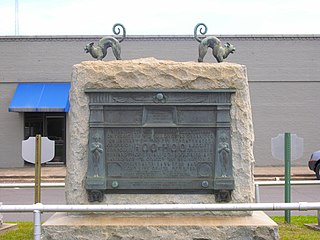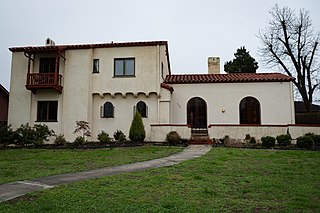
The Rogers Commercial Historic District is a historic district in the central business district of Rogers, Arkansas. When it was first listed on the National Register of Historic Places in 1988, it was known as the Walnut Street Historic District; this was changed when the district was enlarged in 1993. The district encompasses a portion of the city's central business district, whose historical significance extends from about 1885 to the end of the Second World War.

The University of Arkansas Campus Historic District is a historic district that was listed on the National Register of Historic Places on September 23, 2009. The district covers the historic core of the University of Arkansas campus, including 25 buildings.

Galloway Hall is a residence hall on the campus of Hendrix College in Conway, Arkansas. It is a large Tudor Revival three story brick building, designed by architect Charles L. Thompson and built in 1913. Its central portion has a gabled roof, with end pavilions that have hip roofs with gabled dormers, and stepped parapet gables, with limestone trim. It is the oldest dormitory building on the campus. It was named to honor Bishop Charles Betts Galloway.

The Lane Hotel is a historic former hotel building in Rogers, Arkansas, United States. It is a five-story yellow brick Spanish Revival building, designed by architect John Parks Almand and completed in 1929. It is the largest Spanish Revival building in Arkansas, with a prominent colonnade of arches at the second level, above a first floor series of commercial storefronts, and a central tower. The hotel was not successful, having been completed just at the outset of the Great Depression, and went through a succession of owners before closing in 1965. Since 1999 it has been a retirement community known as Peachtree on the Lane.

The Standard Ice Company Building is a historic commercial building at 517 South Main Street in downtown Stuttgart, Arkansas. Constructed in 1926, the building is of the Spanish Revival style, with a tile roof and glazed brick façade. The company manufactured blocks of ice for commercial and residential use, and remained in business until 1978. As household refrigerators became widespread, the facility was used to freeze and pack strawberries, as well as process and freeze ducks killed by local hunters.

The Cumberland Presbyterian Church is a historic church at the junction of Race and Spring Streets in Searcy, Arkansas. It is a single-story buff brick Romanesque Revival structure, with a cross-gable roof configuration and a square tower at the right front corner. The tower houses the main entrance in a pointed-arch recess, and has a louvered belfry at the second level below the pyramidal roof. The church was built in 1903 for a congregation organized in 1824, and is a fine example of Romanesque and Classical Revival architecture.
The Monticello Commercial Historic District encompasses a portion of the historic business district of Monticello, the seat of Drew County, Arkansas. The district was listed on the National Register of Historic Places in 2011.

The Park Hotel is a seven-story hotel in downtown Hot Springs, Arkansas near Bathhouse Row within Hot Springs National Park. Built in 1930 by Thompson, Sanders and Ginocchio in the Spanish Revival style, the hotel was added to the National Register of Historic Places in 1982. The structure continues to operate as hotel today.

The Washington Street Historic District of Camden, Arkansas, encompasses an area that has been a fashionable residential area for much of the city's history. It includes six blocks of Washington Street, three of Graham Street, and three connecting streets. The oldest houses in this area are pre-Civil War Greek Revival houses, built in the 1840s and 1850s when Camden was at its height as a major regional center of the cotton trade. Another round of development took place late in the 19th century after the railroad arrived, resulting in a number of Queen Anne, Colonial Revival, and Classical Revival houses. The last major building spurt took place during southern Arkansas' oil boom in the 1920s and 1930s, when Mission/Spanish Revival, Mediterranean, and English Revival houses were built. The district included 68 contributing properties when it was first listed on the National Register of Historic Places in 2010. Six structures were previously listed separately on the National Register. The district was enlarged in 2018.

The Hoo Hoo Monument on First Street in Gurdon, Arkansas, is a commemoration of the creation of the International Concatenated Order of the Hoo Hoo, a fraternal society of lumbermen founded in Gurdon in 1892. The granite monument with bronze plaque is located near the site of the Hotel Hall where the Hoo Hoo organization was founded. The monument was designed in the Egyptian Revival style by George Zolnay and placed in 1909. The plaque was originally affixed to Hotel Hall, but was moved to the granite marker after the building was demolished in 1927. The monument is a rare Arkansas work by Zolnay.

The Beisel-Mitchell House is a historic house at 420 West Court Street in Paragould, Arkansas. It is a two-story L-shaped Spanish Revival structure with a white stucco exterior, and a low-pitch gable roof clad in red tile. The house was built in 1930 for E. N. Beisel as a wedding present for his wife, and apparently kicked off a minor building boom of similar Spanish Revival houses in the area. It is among the best-preserved and least-altered of those houses.

For the hotel in New York City see Seville Hotel

The Siloam Springs Downtown Historic District encompasses the historic downtown area of Siloam Springs, Arkansas. The district is roughly bounded by University Street, Broadway, and Sager Creek, with a few buildings on adjacent streets outside this triangular area. This business district was developed mainly between about 1896, when the railroad arrived, and 1940, and contains a significant number of buildings dating to that period. It also includes Siloam Springs City Park, the location of the springs that gave the city its name. Notable buildings include the First National Bank building, a c. 1890 Romanesque Revival building, and the c. 1881 Lakeside Hotel, which is one of the city's oldest commercial buildings.

The Mountainaire Hotel Historic District encompasses a pair of former hotel buildings at 1100 Park Avenue in Hot Springs, Arkansas. They are virtually identical four story masonry structures, clad in a buff brick veneer, with stepped facades in an Art Moderne style. They were built about 1947, as part of a planned five-building complex, and are one a small number of Art Moderne buildings in the city. They were built by A.I. Albinson, originally from Minnesota, and operated as a hotel for about twenty years. They were thereafter converted to an elderly care facility. At the time they were listed on the National Register of Historic Places in 2004, the buildings stood vacant.

The Hotel Pines is a historic commercial building at the northwest corner of West 5th and Main Streets in Pine Bluff, Arkansas. It is a large six-story U-shaped masonry structure, with a two-story section filling the center of the U. The center section has a portico projecting over the sidewalk, with Classical Revival detailing and paired columns for support. Built in 1913 and in operation as a hotel until 1970, it was Pine Bluff's grandest hotel.

The First Lutheran Church is a historic church building at 1700 Central Avenue in Hot Springs, Arkansas. It is a single story structure with a stuccoed exterior and a long gabled roof. Its main facade, facing east, has a centered entrance set in a stepped back rounded arch, with flanking windows that have ornamental ironwork on the outside. An open belltower rises at the peak of the gable above the entrance. Built in 1937 to a design by St. Louis architect Carl T. Schloemann, it is a distinctive late example of Mission Revival architecture in the city. The Lutheran congregation for which it was built was established in 1915; the building was sold into private ownership in 1985.

The Letona Hotel is a historic former hotel building, between North Hotel and North Spain Streets, just north of Arkansas Highway 310 in Letona, Arkansas. It is a 2-1/2 story wood frame structure, with a hip roof and novelty siding. A two-level porch extends across its eastern facade, supported by square posts. Built about 1910, it is a surviving reminder of the time when Letona was a major lumber shipment point on the Missouri and North Arkansas Railroad.

The Searcy Municipal Courthouse, formerly the Searcy Post Office is a historic government building at Gum and Arch Streets in downtown Searcy, Arkansas. It is a two-story brick building with Renaissance Revival styling. The central bays of its main facade are articulated by paneled pilasters of the Corinthian order, with large two-story windows flanking a two-story entrance, all set in recessed segmented-arch openings. The shallow hipped roof has elongated eaves with large brackets. The building was designed by Oscar Wenderoth and built in 1914, and is the only high-style Renaissance Revival building in White County.

The Terminal Hotel is a historic commercial building at Victory and Markham Streets in Little Rock, Arkansas. It is a three-story Classical Revival brick building, set across Victory Street from Little Rock Union Station. It was built in 1905 as a railroad hotel, and has since been converted into residential housing units.

The Taylor Hill Hotel is a historic former hotel building at 409 Alabama Street in Coal Hill, Arkansas. Now a private residence, it is a two-story wood-frame I-house, with a gabled roof and weatherboard siding. A two-story ell extends to the rear, giving the building a T shape. A two-story porch extends across much of the front, supported by square columns. The building has a mixture of simple Greek Revival and Folk Victorian details. It was probably built about 1890, when Coal Hill was the largest city in Johnson County.
























